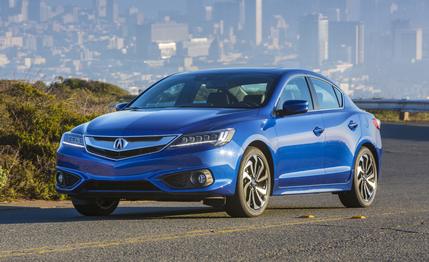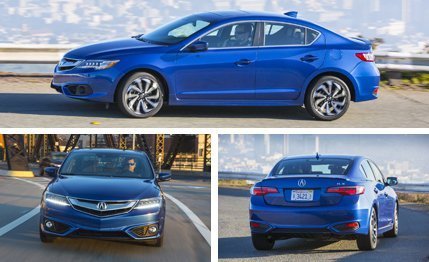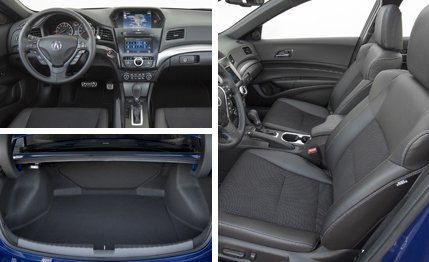 First Drive Review
First Drive Review
Upon first hearing Acura officials refer to the 2016 ILX as “The Gateway,” we imagine something ominous, like hooking kids on smack or opening a portal to a demonic underworld. Recalling our first go-round with this slight sedan in our long-term fleet, however, either option seems too weighty. And sure enough, the nice (or is that nicest?) people from Honda’s luxury brand explain that this model is meant to be the Acura that sets up the young and aspirational as “customers for life.” Which actually is pretty ominous.
Competing, as ever, in the class of $30,000-ish luxury cars that aren’t really luxury cars, the ILX remains essentially a fortified Honda Civic. Additional mid-product-cycle polish comes to its specifications mostly by discarding the old car’s 150-hp, 2.0-liter four-cylinder and five-speed automatic in favor of a direct-injected 2.4-liter four that makes 201 horsepower and 180 lb-ft of torque. Honda’s novel torque-converter-equipped dual-clutch automatic transmission now swaps eight forward gears and drops cruising revs to a palatable level, a great improvement over the old car’s high-strung powertrain. With this new combination, the same as used in some versions of the larger Acura TLX, we estimate that the 2016 ILX should hit 60 mph more than two seconds quicker than did last year’s 2.0-liter model.

The new gearbox is a sonnet to smoothness but an elegy to the enthusiast, as there is no longer a manual-transmission model in the ILX lineup. Also gone is the hybrid, which Acura canceled a year ago to neither much surprise nor notice. For most buyers, the new powertrain is the equivalent of getting upgraded to first class from that last middle seat on the plane, the one near the lavatory. But for those fewer than five percent of ILX buyers who opted for the old six-speed manual, which came lashed to a different, port-injected 2.4-liter four-cylinder, the performance differential will be insignificant. (The old engine made the same power but 10 fewer lb-ft of torque.) Lest those pilots remain content flying their old ILX models, Acura has made other mechanical upgrades.
New calibration to the electric assist makes the steering in the 2016 ILX a bit slower but weightier and more direct than before, which Acura says is helped in part by a beefier front subframe. The front suspension bushings are upgraded and the rear anti-roll bar increases by a millimeter in diameter to improve initial turn-in. The front brake rotors now measure 12.3 inches, up from 11.8 in the old 2.4-liter car, and the rears are bigger, as well. As would be expected from such changes, the improved brakes bite harder and the firmer pedal is easier to modulate than before.
Although the ILX now delivers more feedback and a more immediate response to the road, this also makes the conservative suspension tuning more apparent. Curb weight is up by about 150 pounds and the balance of that mass shifts forward from 61 to 63 percent over the front drive wheels, which doesn’t help with understeer or the feeling that the rear of the car is merely being towed around. When equipped with new 18-inch wheels, the back end is also prone to impact harshness and subsequent excessive vertical motion.

The bigger wheels are part of the new “A-Spec” package, which also replaces the 17-inch Michelin Pilot HX MXM4 all-seasons with 18-inch Continental ContiProContact all-seasons. The $1990 package otherwise is cosmetic, bundling fog lights, sill extensions, and a spoiler along with suede-trimmed seats and sport pedals. A-spec can be added to either of the top two ILX trim levels, Premium ($30,820) or Tech Plus ($33,820). The latter brings with it navigation, a premium audio system, and AcuraWatch, a suite of safety equipment including adaptive cruise control, front collision warning, and lane-keeping assistance. A base ILX starts at just $28,820, or $30,120 with AcuraWatch. While all ILX trims get new exterior styling cues, a bit nicer finishes inside, and most even adopt Acura’s double-touch-screen infotainment system, these revisions come across as less vital than those to the hardware.
The ILX is clearly improved over last year’s model, but Honda is still faced with the underlying problem that there’s not enough space between its mass-market products and those sold by its luxury marque. Or at least enough to overcome the Acura badge’s lack of snob appeal compared with its competition from Audi, Mercedes, and BMW, however unfair that may be. With the German luxury brands actively attacking the ILX’s pricing turf, standing out at the low end of the luxury spectrum is only getting more challenging.